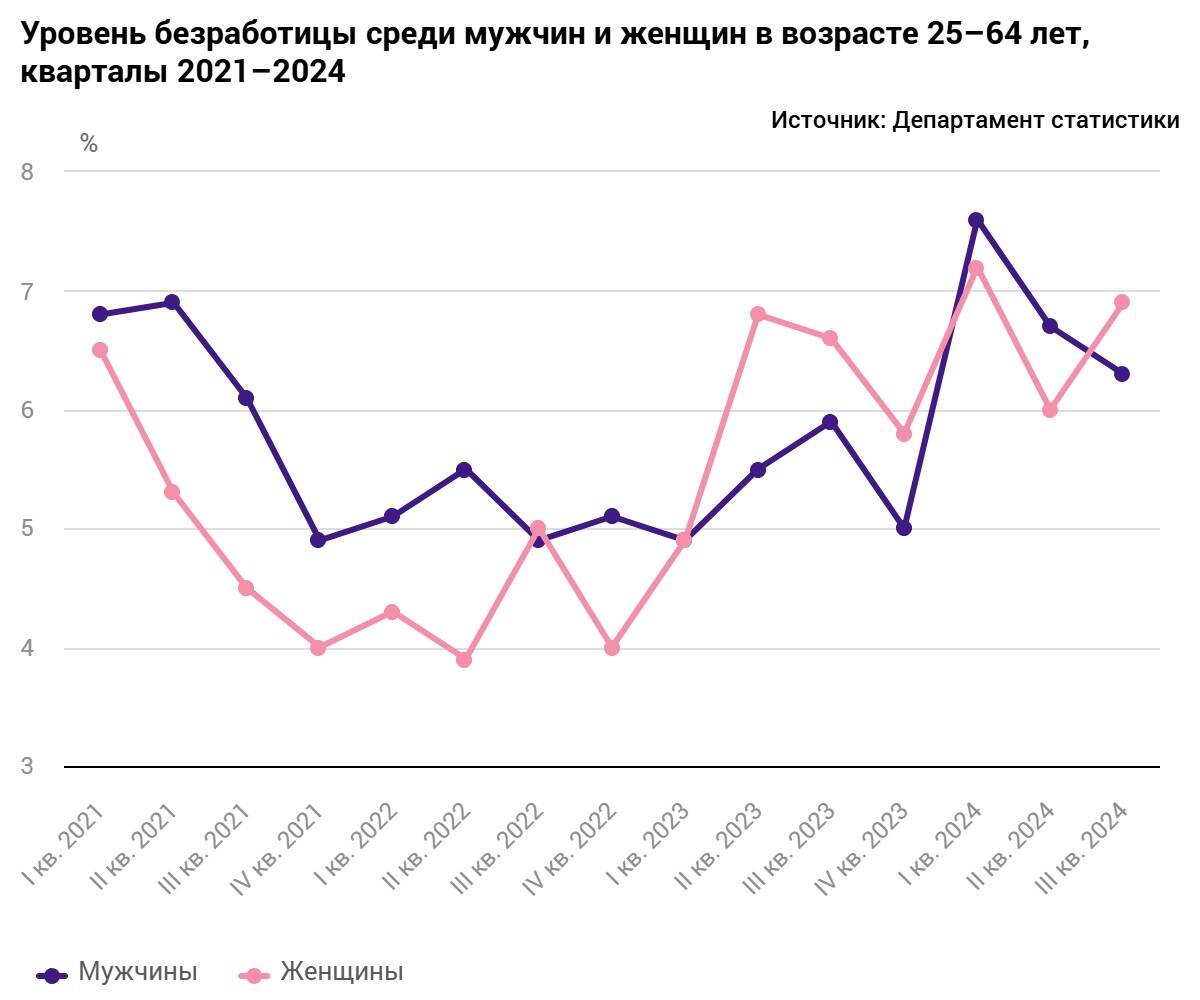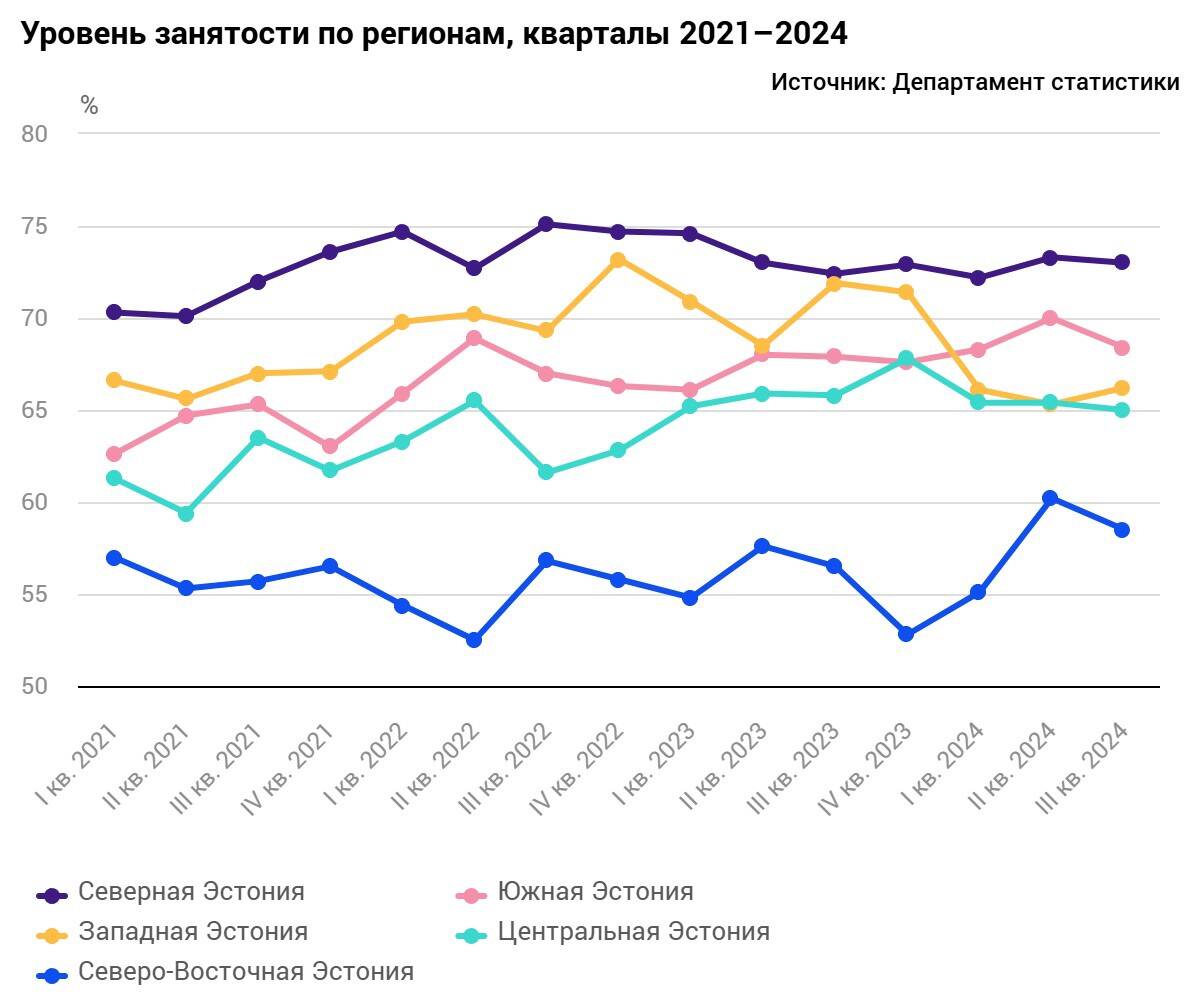According to the Department of Statistics, the unemployment rate in the third quarter of 2024 was 7.4%, the labor force participation rate was 69.1%, and the labor force participation rate was 74.6%. Compared to the previous quarter, there were 1,500 fewer unemployed.
Department of Statistics analyst Tea Vasilyeva explained that compared to the second quarter, the unemployment rate decreased by 0.2 percentage points: “In the third quarter, there were 56,300 unemployed, and since the beginning of the year their number has gradually decreased, but there were still 1,500 more,” than in the third quarter of 2023.”
Compared to the second quarter of this year, in the third quarter the number of unemployed decreased by 1,500 people. The decrease in unemployment in the previous quarter took place mainly among men and young people aged 15-24 years. “There were 2,300 fewer unemployed people in this age group in the third quarter than in the second quarter, while among women aged 25-64 the number of unemployed people increased by 2,700 people. Among men of the same age, there are 1,600 fewer unemployed,” the analyst noted.
The summer workforce peaked in the second quarter.
In annual comparison, the unemployment rate increased fairly evenly in all age groups. Among those aged 15-74, the unemployment rate was 7.4%, up 0.1 percentage point from the third quarter of 2023.
The analyst explained that during the summer months, interest in work traditionally increases, especially among young people, and therefore the labor force participation rate also increases, that is, the proportion of people of working age who either work or want to work and are looking for work.
“This year, the summer workforce peaked in the second quarter, and the workforce declined by the third quarter. As a result, in the third quarter not only the number of unemployed people decreased, but also the number of employed people,” Vasilyeva said.
Compared to the second quarter, the number of employees decreased by 6,500 people
Compared to the third quarter of last year, the number of employees increased by 6,300 people. The quarterly decrease of 6,500 people was mainly due to women – in the third quarter there were 5,800 fewer women working than in the second quarter. The number of working men during this period decreased by 700 people.
Compared to the third quarter of last year, the number of people employed increased in the agriculture, forestry and fisheries sectors, as well as in industry and construction, but fell slightly in the services sector. Compared to the second quarter of this year, the number of employees increased only in industry and construction. The services sector employed 16,100 fewer people in the third quarter than in the second quarter.
In annual comparison, the employment level remained at the same level
In a regional comparison, in the third quarter of this year, compared to the previous quarter, the number of employed men in Tallinn increased by 9,500, while the number of employed women decreased by 8,600.
“In the rest of Harju County the situation was reversed: compared to the second quarter, there were 4,700 fewer employed men and 2,500 more employed women. In Central and North-Eastern Estonia, women’s employment has also increased, while men’s employment has decreased. In Southern Estonia, the number of employed men and women decreased during the quarter,” the analyst added.
The annual increase in employment by 6,300 people was driven by women, mainly in Northern Estonia – in the third quarter of this year, there were 6,400 more employed women than last year, while the number of employed men decreased by 100. Compared to last year in Harju County the number of employed people increased by 7,100 people, and in Ida-Viru County by 2,000. In other regions, the number of employed people decreased over the year.
In the third quarter, the employment rate was 69.1%, remaining exactly at the same level as a year ago. During the quarter, the employment rate decreased by 0.6 percentage points. By region, the highest employment rate remains in Northern Estonia, and the lowest in North-Eastern Estonia.
Along with a decrease in the number of unemployed and employed people, the number of people outside the labor force, that is, economically inactive, increased in the third quarter. There were 7,900 more of them in the third quarter of this year than in the second quarter, and 1,700 more than a year ago. The labor force participation rate was 74.6%, down 0.8 percentage points from the second quarter but 0.1 percentage points higher than a year earlier.
Labor force statistics reflect permanent residents of Estonia who have been living or planning to live in Estonia for at least one year. The number of war refugees from Ukraine with temporary protection covered by the labor force survey is insufficient to provide estimates concerning them.
Related articles
The economic downturn this year will be deeper than previously expected, but a gradual recovery will begin in the coming years.
Because of the war, logistics and transportation faced falling demand in the west and bureaucratic obstacles in the east. And then came new EU requirements for tachographs and tightened controls on the border with Russia. The Far East spoke with the CEO of the logistics company Garant Trans, Igor Rabtsevich, about the situation in the industry and its prospects.
Eight quarters of economic contraction have left their mark, and the recovery from the crisis will be quite slow. The Estonian economy has several strengths that will help cope with its consequences, but the future does not seem entirely rosy, warns Swedbank’s head of credit risk control Urmas Simson.
According to Luminor’s autumn economic forecast, due to low investment, government spending cuts and tax increases, Estonia’s economic growth will be only 1% next year.
All companies involved in the storage, transportation or handling of goods are well aware of what an important investment the purchase of a forklift is. Choosing the right forklift helps improve operational efficiency, improve workflow and improve workplace safety. In this article, let’s look at what factors you should consider to make an informed decision about purchasing a forklift, as well as take a look at the trends and potential of the future.
Source: www.dv.ee



